
Just about every motorist has (or should have) an understanding of the importance of running the correct air pressures in their vehicle’s tyres for on-road driving, no matter what type of vehicle they drive.
The correct tyre pressures ensure optimum vehicle performance in terms of traction, grip, ride quality and fuel economy, as well as optimum tyre life in terms of tyre wear across the tread face, as well as sidewall longevity.
Throw off-road driving into the mix and the importance of setting the correct tyre pressures is even greater. Adjusting air pressure to suit different terrain types will not only improve vehicle performance and ride quality, and prolong tyre life, but it will also minimise track damage.
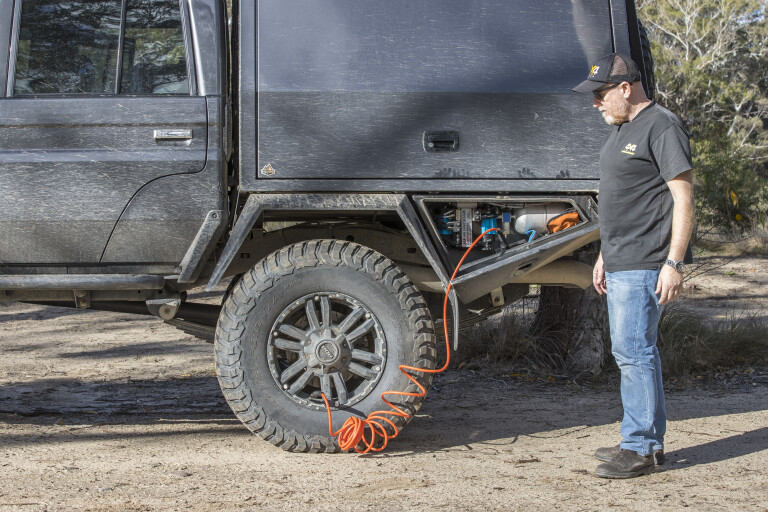
While many four-wheel drivers are well-versed in the need to lower tyre pressures for sand driving, many don’t understand the benefits of lowering pressures for driving on other surfaces such as gravel roads and dirt tracks, or through mud and over rocks.
Before we go any further, it should be noted that the recommended pressures listed in this guide are just that, recommendations.
It should also be noted that these recommendations are for vehicles fitted with Light Truck (LT) construction tyres, which have a stronger carcass, both across the tread face and in the sidewalls, than the Passenger Car (P) rated tyres that are often standard fitment on many new 4x4s.
Also bear in mind that heavily laden vehicles will need to run higher air pressures in their tyres than lightly laden vehicles will.
JUMP AHEAD
- Road pressures
- Gravel and dirt roads
- Rocky terrain
- Mud terrain
- Sand terrain
- Remember to reinflate
- Required equipment
- Expert opinion
- Dos and do nots
- Technical details, with Chris Collard
Road pressures
To figure out a start point when it comes to setting the correct tyre pressures for on-road driving, just look at your vehicle’s tyre placard. But bear in mind that while the tyre placard will list different tyre pressure recommendations for different OE tyre sizes, you might have to adjust pressures to suit aftermarket LT tyres if fitted. The placard will also likely list higher pressures for when the vehicle is carrying a load, and this is an important consideration, especially for 4x4 utes that have high payload capacities.
If a vehicle is carrying a heavy load, it might be necessary to run higher pressures in the rear tyres than the front. Likewise, a vehicle equipped with a steel bullbar, a winch and driving lights will likely need higher tyre pressures up front than what is listed on the tyre placard.
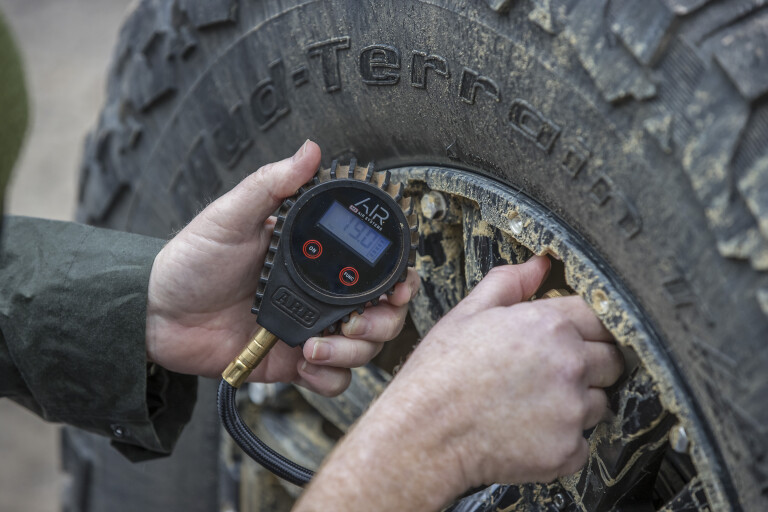
Figuring out the ‘perfect’ on-road tyre pressures to suit your vehicle is often a case of trial and error, and it will depend on how you want your vehicle to behave on the road in terms of ride quality, steering response and handling.
It is important not to go too extreme when adjusting tyre pressures for on-road driving. Go too low and the tyres will flex a lot in the sidewalls and generate too much heat, which can result in tyre delamination, which is essentially where the tyre separates in to its various components. Go too high with pressures and ride quality will suffer through a lack of sidewall flex, and the tyres will also be more prone to punctures.
Pressures also have a big effect on tyre life; overinflated tyres will wear prematurely in the centre of the tread area, whereas underinflated tyres will wear more on the outside of the tread area. With the right inflation pressures, the tyres should wear evenly across the tread face, assuming the wheels are correctly aligned and balanced.
Gravel and dirt roads
Driving on gravel roads and dirt tracks is very different to driving on sealed roads, so it’s important to adjust tyre pressures to suit the conditions.
For smooth and well-graded gravel roads on which you can easily maintain highway speeds, you might be able to stick to your on-road tyre pressures, but the loose surface will mean you have reduced traction and grip, resulting in compromised cornering capability as well as extended braking distances. Lowering tyre pressures results in a longer tyre footprint for improved traction and grip, and more flexible sidewalls for better ride quality.
How much should you lower tyre pressures? As a general guide, if you run 35psi on the road you might want to go down to 30psi on smooth gravel roads. And if the road surface deteriorates, you can lower pressures further still.
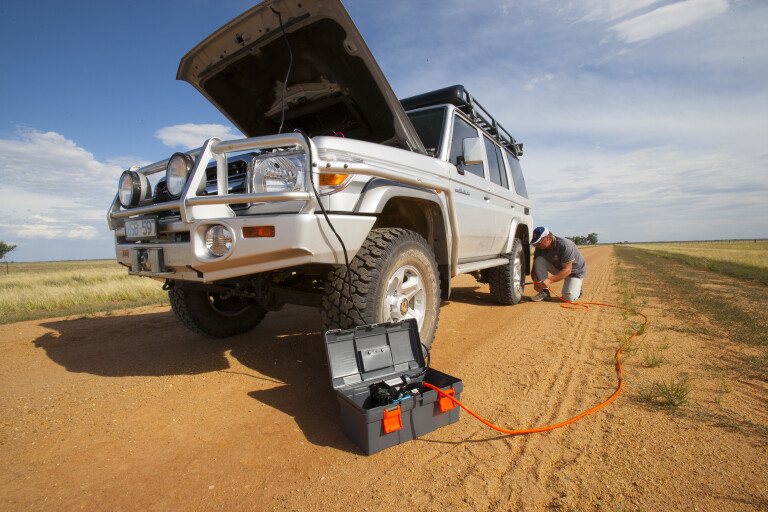
From experience, I’d suggest somewhere between 32psi to as low as 26psi is suitable for rough gravel roads, depending on the load you are carrying. If for example, your on-road tyre pressures were at 38psi, drop to 32psi or so on rough gravel and see how the vehicle rides and handles. If you are running 35psi on the road, then maybe drop to around 26psi on rough gravel roads.
You, your passengers and your vehicle will appreciate the many benefits of running lower tyre pressures on heavily corrugated roads. The vastly improved ride quality you’ll experience by lowering tyre pressures is beneficial for the comfort of vehicle occupants and it makes driving less tiring. Lower pressures also minimise potential vehicle damage caused by incessant vibrations, and result in more grip, making the vehicle easier to drive.
As well as offering better traction, grip and ride quality, lowering tyre pressures for gravel roads also reduces the risk of chipping across the tyre tread face, as the tyres are more flexible and therefore less prone to impacts from sharp stones and rocks.
Rocky terrain
Reducing tyre pressures in rocky terrain allows the tyres to flex, which means they can better conform to uneven terrain, in turn improving traction and reducing the chance of tyre damage. As mentioned, lower tyre pressures also result in a longer tyre footprint, which means better traction.
If you’re crawling over rocky terrain in low range, you can lower tyre pressures quite a lot, as heat generation from high-speed driving will not be an issue. How low? If you run tough LT tyres, 22psi is a good starting point for rock crawling, but make sure your throttle and steering inputs are gentle and well-considered, because abrupt acceleration or steering inputs can result in the tyres slipping on their respective rims, which can lead to deflation, or the tyres coming off the rims altogether.
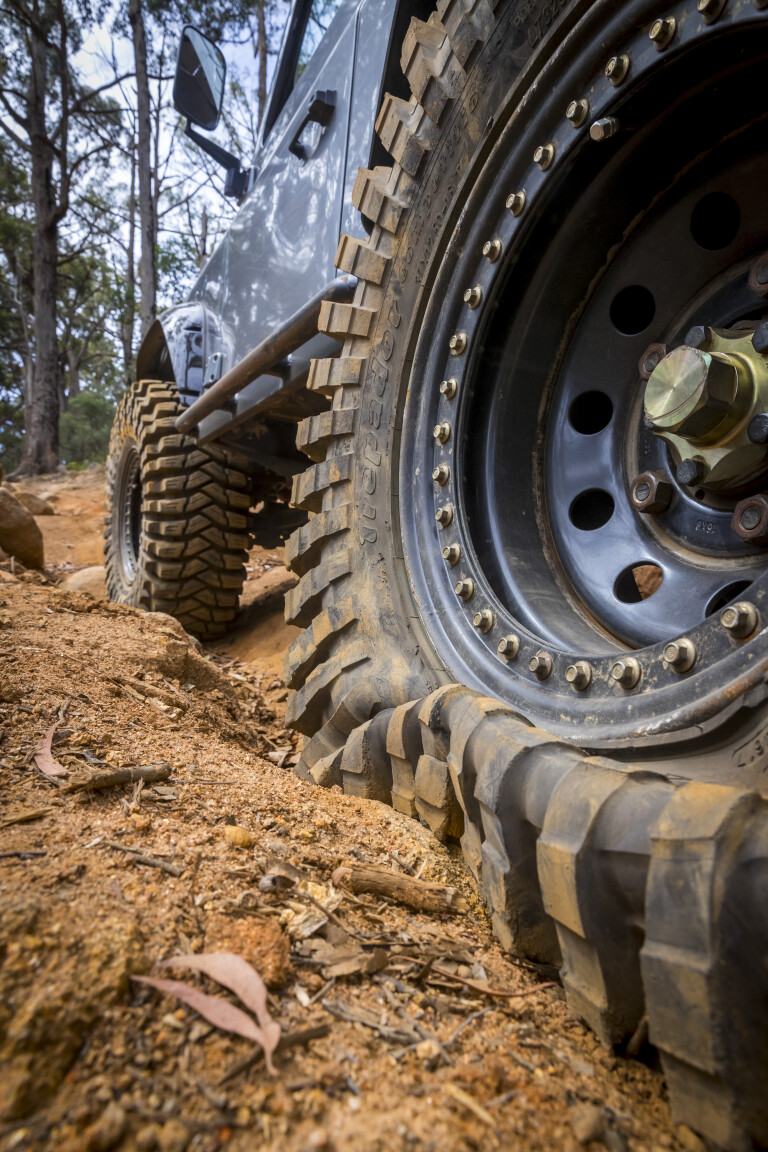
There is a downside to lowering tyre pressures in rocky terrain, and that is increased susceptibility to sidewall damage. As you lower pressures, the tyre sidewalls bag out, so make sure you keep an eye out for sharp rocks or protruding tree roots and the like in rocky terrain.
When track conditions improve, remember to reinflate your tyres; as your speed picks up, so too will tyre temperatures, and therefore the risk of tyre damage.
Mud terrain
The right tyre pressures for mud driving depends on what type of mud you’re driving in.
What type of mud?! Well, if the mud is slippery and slimy on the surface, but you can feel a firm base underneath, then gravel-road tyre pressures (26 to 30psi) will allow the tyres to cut through the top layer and hopefully gain purchase on the firm base.
If the mud is deep and gooey, and you can’t feel a firm base at all, dropping tyre pressures to as low as 22psi will hopefully give them a chance of gaining purchase in the slop, thanks to the resulting longer tyre footprint.
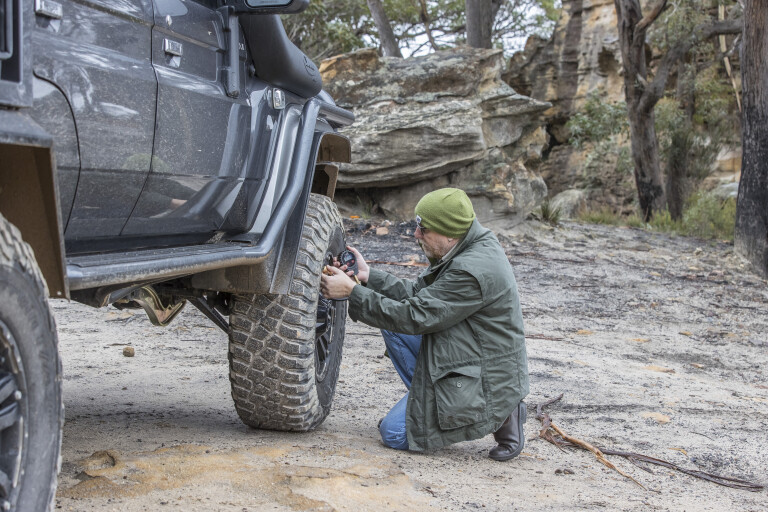
As with rock driving, if you have lowered tyre pressures significantly to get through mud, don’t make sudden throttle or steering inputs, as the tyre could slip on the rim or mud could work its way in between the bead and the rim, resulting in rapid tyre deflation.
With bead-locks fitted, ensuring the tyres cannot slip or peel off their respective rims, you can drop pressures even further for mud driving, but check the legality of such devices in your state or territory before going down this route.
Sand terrain
Lowering tyre pressures for sand driving seems to be the one everyone knows about, but how low should you go, and why?
Let’s start with the ‘why?’. As already discussed, lowering tyre pressures increases the tyre footprint, and in sand this helps the tyres to float over the surface rather than dig in to it.
So, how low should you go? In soft sand, you can safely drop tyre pressures to as low as 16psi without peeling them off their respective rims, so long as you don’t make sudden steering movements or corner at great speeds. And remember, don’t drive too fast on sand with low pressures as heat will quickly build up and cause tyre damage.

On harder-packed sand you might not have to lower pressures as much. You’ll figure it out as you go along by judging how easy or difficult it is to maintain forward progress; if it’s easy, don’t drop pressures too much, but if it feels like a hard slog, go lower.
Dropping tyre pressures in sand not only reduces the chance of getting bogged, it also reduces the strain on your vehicle and it minimises the occurrence of track damage, so don’t be one of ‘those blokes’ who doesn’t feel the need to lower tyre pressures on sand.
Remember to reinflate
Make sure you reinflate your tyres to on-road pressures once you’re back on the blacktop. While you’re pumping them up, have a good look over the tyres to see if there are any signs of damage, in which case you’ll have to repair or replace the tyre with a spare. Check the valve stems for leaks too, and make sure the dust caps are screwed back on once the tyres have been reinflated.
If you only have a short distance of blacktop before you’ll be back on gravel again, you can maintain lower tyre pressures, but make sure you keep your speed down so your tyres don’t overheat.
Required gear
This is the gear you’ll need to regularly adjust tyre pressures to suit off-road terrain, and you should have in your kit in the case of tyre damage:
• Quality tyre pressure gauge
• Tyre deflator (or a stick if you’ve got all day)
• Quality air compressor
• Tyre repair kit
• Spare tyre in good condition
• Functioning vehicle jack and wheel brace
• Tyre Pressure Monitoring System (TPMS)
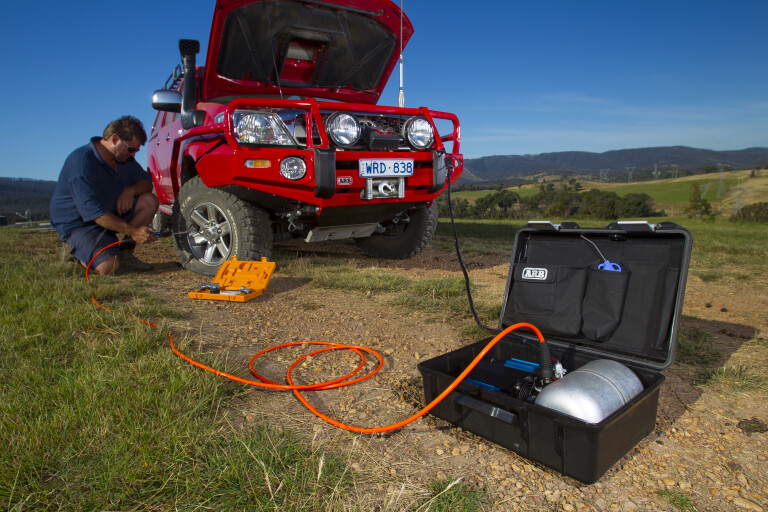
Expert opinion
Adventure 4WD Director David Wilson has been a four-wheel drive trainer since before Google was a thing and, among other things, he’s also the face of Isuzu’s I-Venture Club. We had a chat with him a few years ago to get his top five tips for managing tyre pressures; this is what he reckons.

1. Start with your tyre placard for on-road pressures
Let’s start with your on-roads. Most of us drive around on bitumen roads most of the time, so paying attention to your tyre placard and what it says is your starting point. Most wagons and utes start at about 200kPa/29psi and go up to around 250kPa/36psi when laden.
These pressures will work on the blacktop for 99 per cent of drivers. But we see over-inflation all the time and it’s stupidly unnecessary, wearing tyres out prematurely, increasing puncture susceptibility, extending emergency braking distances and more.
2. Follow the ‘20 per cent’ rule
When you venture on to a dirt road, those bitumen pressures will be too high and can contribute to a loss of control. We’ve coined our ‘20 per cent rule’ and it works a treat when travelling big distances on dirt roads.
In a nutshell, if you’re going to be on dirt for a while, let 20 per cent of the placarded pressure out and slow down by 20 per cent. So, with now early-mid 20s psi and a maximum speed of 80km/h, you’ll have a tyre that’s flexible and able to absorb the bumps, and defeat most puncture events, to give you a more comfortable ride and shorter emergency braking distances.
3. Keep going down
As the track-space further deteriorates, keep incrementally letting more air out until you reach a point where traction and momentum is restored and progress is once more a breeze. Remember, though, with each deflation your speed, too, needs to incrementally reduce so the tyre doesn’t get hot and bothered.
4. Don’t go too low
Your minimum pressure should be 100kPa/15psi for all but emergencies (or what I sometimes call divorce pressures – you know, bogged on a beach with a rising tide!). At 15psi or less you’ll need to be really, really careful about your steering, braking and accelerator inputs as there’s now so little air in the tyre it might come off the rim.
5. Pump them back up
At day’s end pump your tyres back up to an appropriate pressure for the surface you are driving on. The fastest way to do that is using an air compressor like ARB’s twin motor compressor – those things are fast! Check the pressure with a reliable dial-type gauge of metal construction.
Dos and do nots
Do
1. Adjust pressures to suit terrain and vehicle load
2. Fit LT tyres to your vehicle
3. Regularly check tyres for damage
4. Run a TPMS to warn of rapid deflation
5. Remember to reinflate once back on the road
Do not
1. Lower tyre pressures too much for conditions
2. Drive too fast with lowered tyre pressures
3. Make sudden throttle or steering inputs with low tyre pressures
4. Leave your compressor and tyre repair kit at home
5. Get lazy and forget to adjust tyre pressures
Technical details, with Chris Collard
Sometime in the early 1980s I was on one of my first four-wheel drive trips with my new Toyota HiLux. Stopping at the trailhead, everyone started letting air out of their tyres. Clueless as to why I asked one of the guys, “Whatcha doing?”
With his two-word reply, “Airing down,” I asked the next dumb question… “Why?” His brief explanation, which included something about traction, began a multi-decade edification on the merits of reduced air pressure.
What I’ve learned along the way is that in the same way the Inuit use many words to describe snow, there are numerous variables when it comes to airing down. This month we’re diving into the why, when and how much, when it comes to lowering the bar.
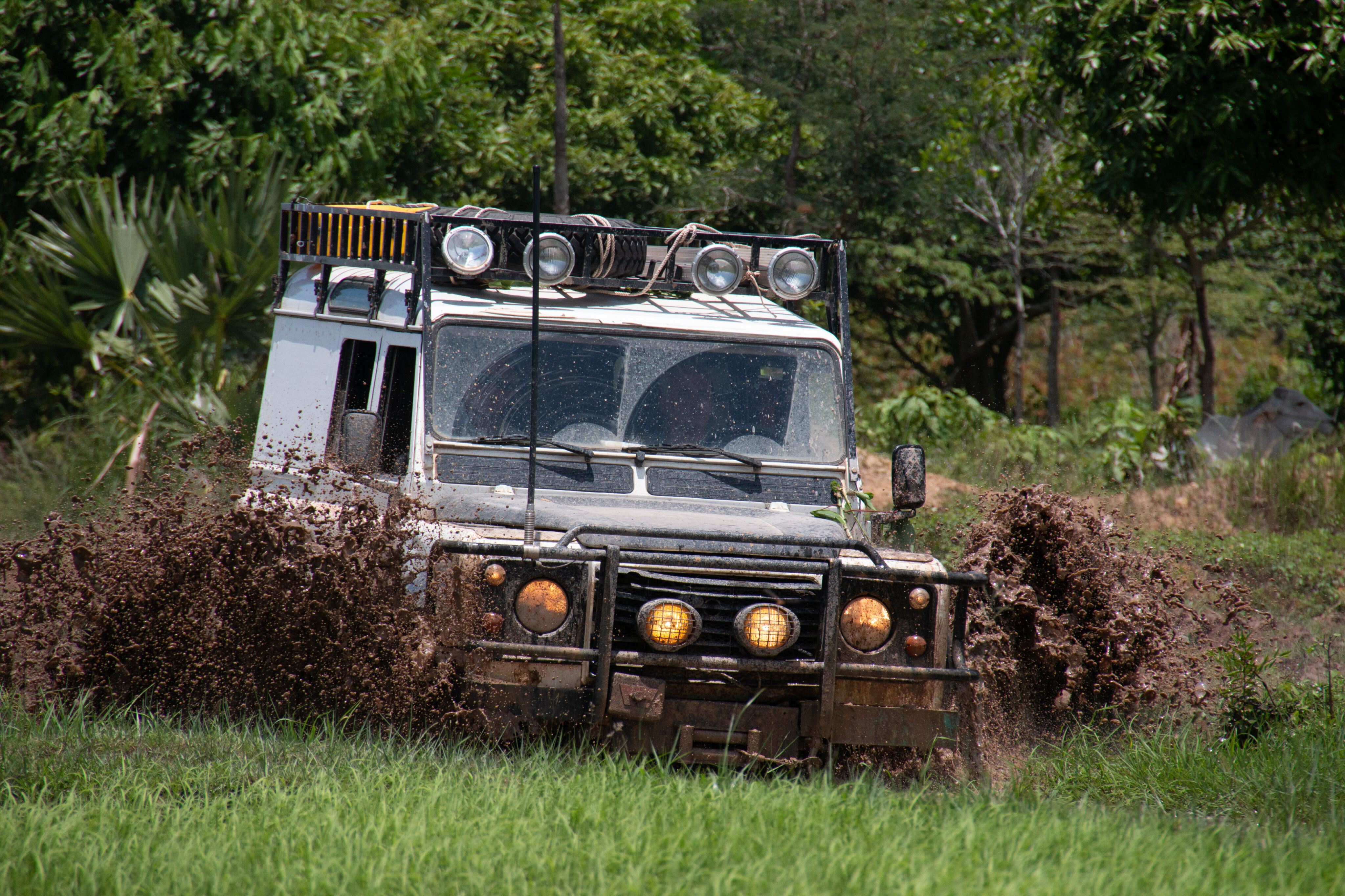
Many variables
Today, when someone asks me how much they should air down I usually respond, “I have no idea,” and initiate a discussion on the variables that might affect my answer.
Things to consider are wheel diameter and tyre aspect ratio, type of tyre and load rating, weight of vehicle, do they have standard wheels or beadlocks, what is their driving style, and what type of terrain. The latter (insert mud, snow, sand, granite, etc.) can be broken down into an infinite number of subcategories, each with an ideal pressure based on any combination of the former.
TIP: The appropriate tyre pressure will vary depending on rim diameter, tyre aspect ratio, vehicle weight, and type of terrain.
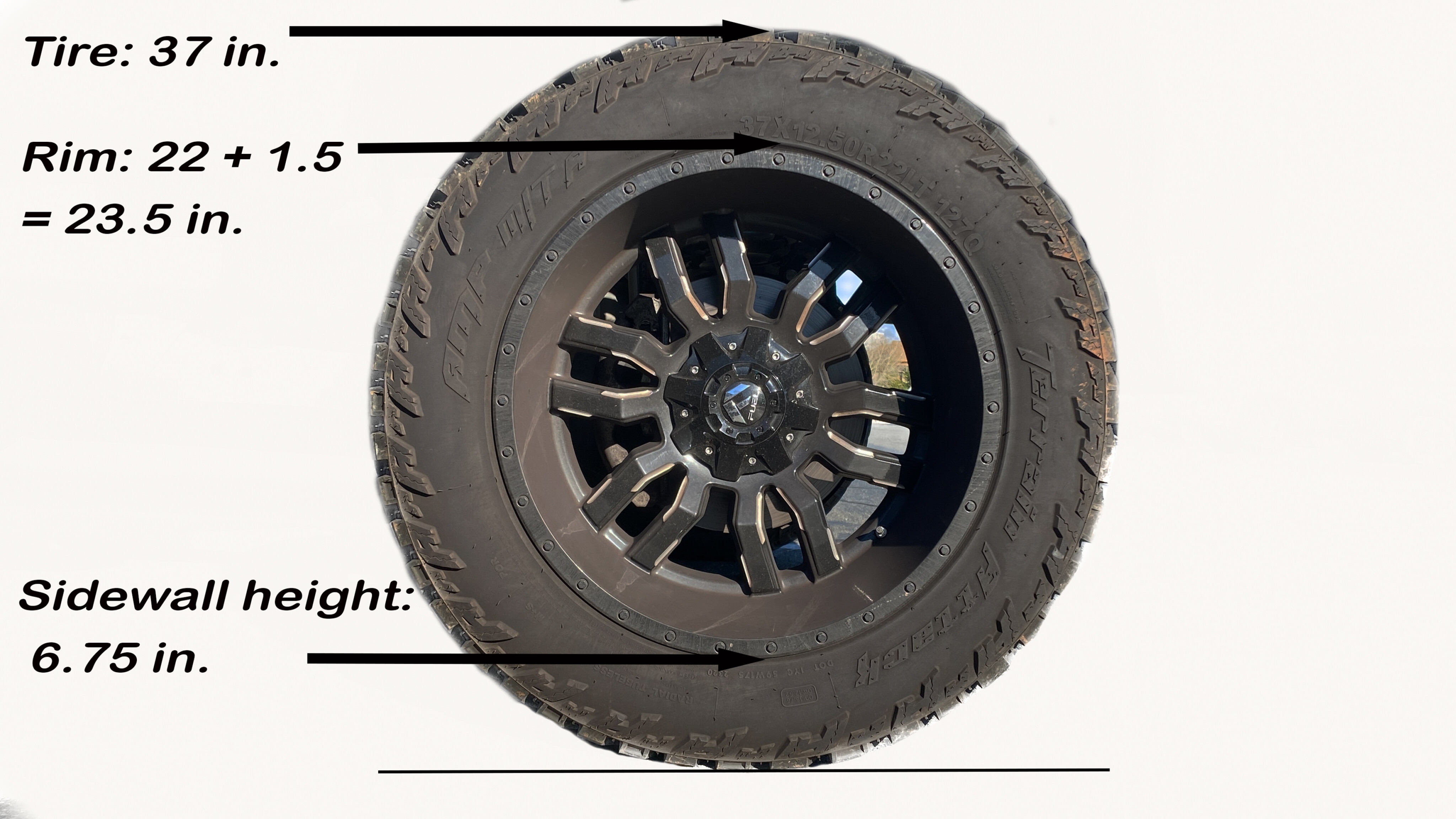
Wheel diameter, sidewall and load/speed rating
Let’s first look at wheel diameter and width, as well as tyre aspect ratio. During the last decade there has been a shift toward big wheel diameters (18s, 20s, and larger) and shorter aspect ratios.
Vehicle manufacturers are guilty on all counts, but we must cut them some slack. In order to accommodate increased brake caliper size (bigger rotors, shorter stopping distances, safer cars) and reduce rolling resistance and mass (complying with stringent government requirements), large wheel diameters and low-profile tyres are a necessary evil. Otherwise, big-diameter wheels have limited backcountry value in my opinion.
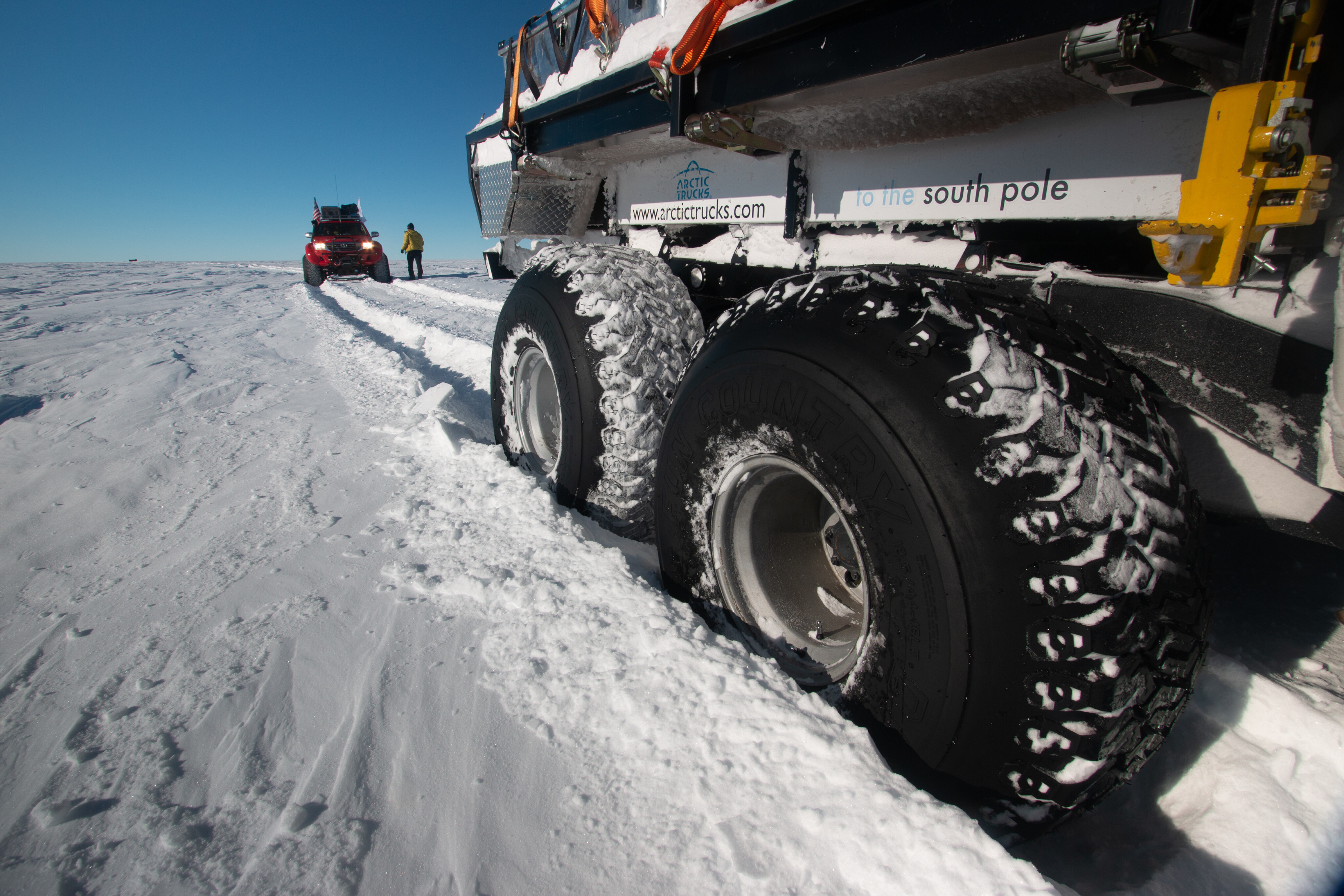
Theoretically, a 33-inch tyre on a 16-inch wheel should give you 8.5 inches (215mm) of sidewall between the rim and terra firma.
Wrong! The bead seat and flange increase overall rim diameter by about 1.5 inches (17.5 in actual) which leaves us with 7.75 inches (200mm) of sidewall.
Additionally, you can deduct another inch (+/-) for rolling diameter vs manufacturer specs, which drops sidewall height to a still-respectable 7.25 inches (185mm). If we do the math for the same 33-inch tyre on a 20-inch wheel, we end up with a paltry 5.25-inch (135mm) sidewall.
TIP: Large-diameter wheels equate to a shorter sidewall, which limits the ability to reduce tyre pressure.

Load rating also affects how the tyre reacts to reduced pressure.
An E rated tyre will typically have more plies, a higher maximum psi, speed rating, and weight capacity, and a stiffer sidewall than a load range C tyre. Having said this, a lighter vehicle can get away with a softer, more flexible tyre.

Deformation versus ground clearance
You might ask why sidewall height is important? Reducing air pressure allows the tyre to deform, or flatten slightly, which increases the contact patch.
In loose sand, as well as soft snow and mud, this larger contact patch allows for greater floatation. In rocky terrain the softer tyre will conform to obstacles, putting more rubber on the tractive surface. Think, sticking your pinky finger into a marshmallow versus a cricket ball. The marshmallow is soft and compliant while the baseball will break your finger.
TIP: Floatation is key when traversing soft sand and snow.
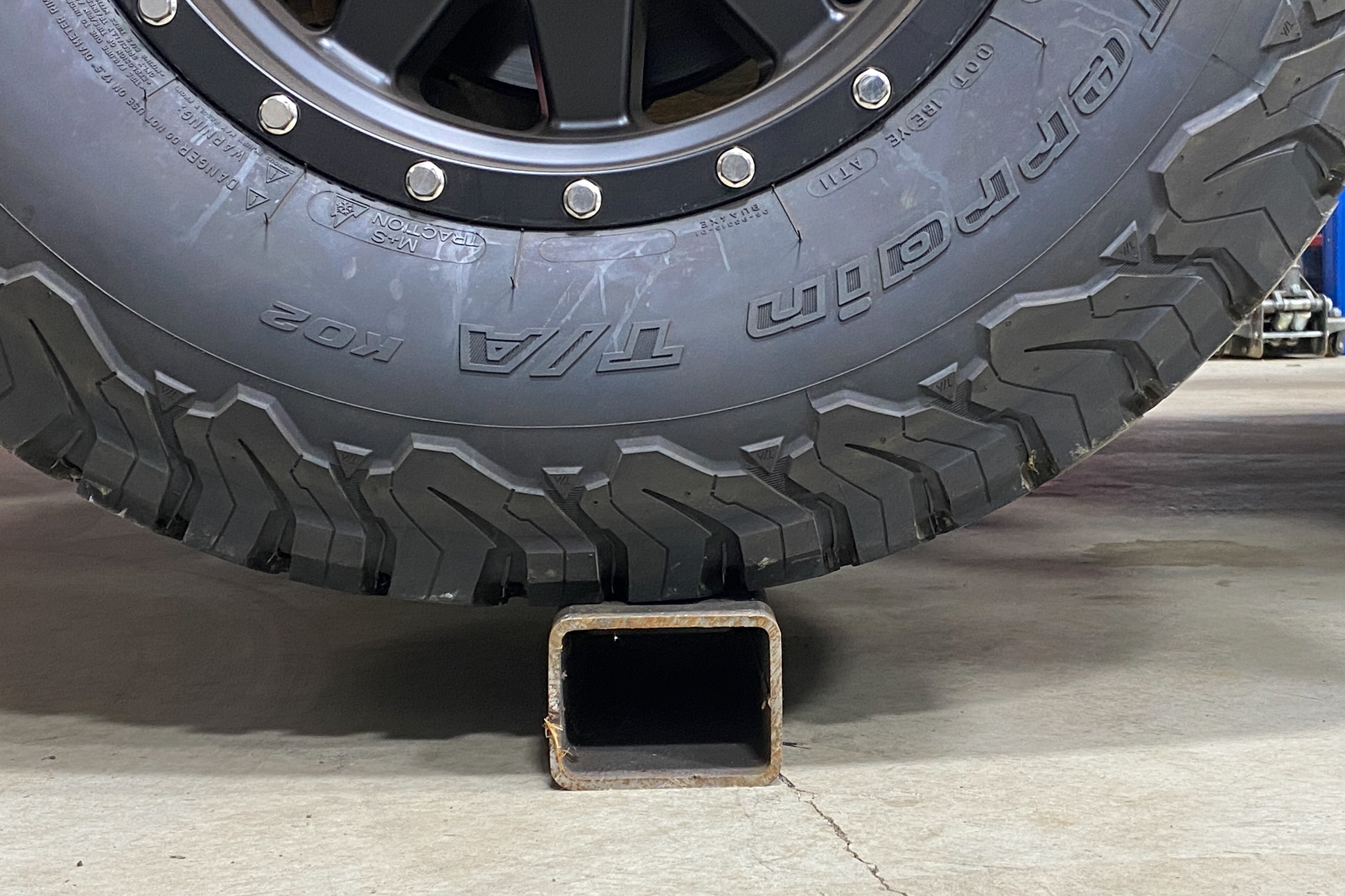
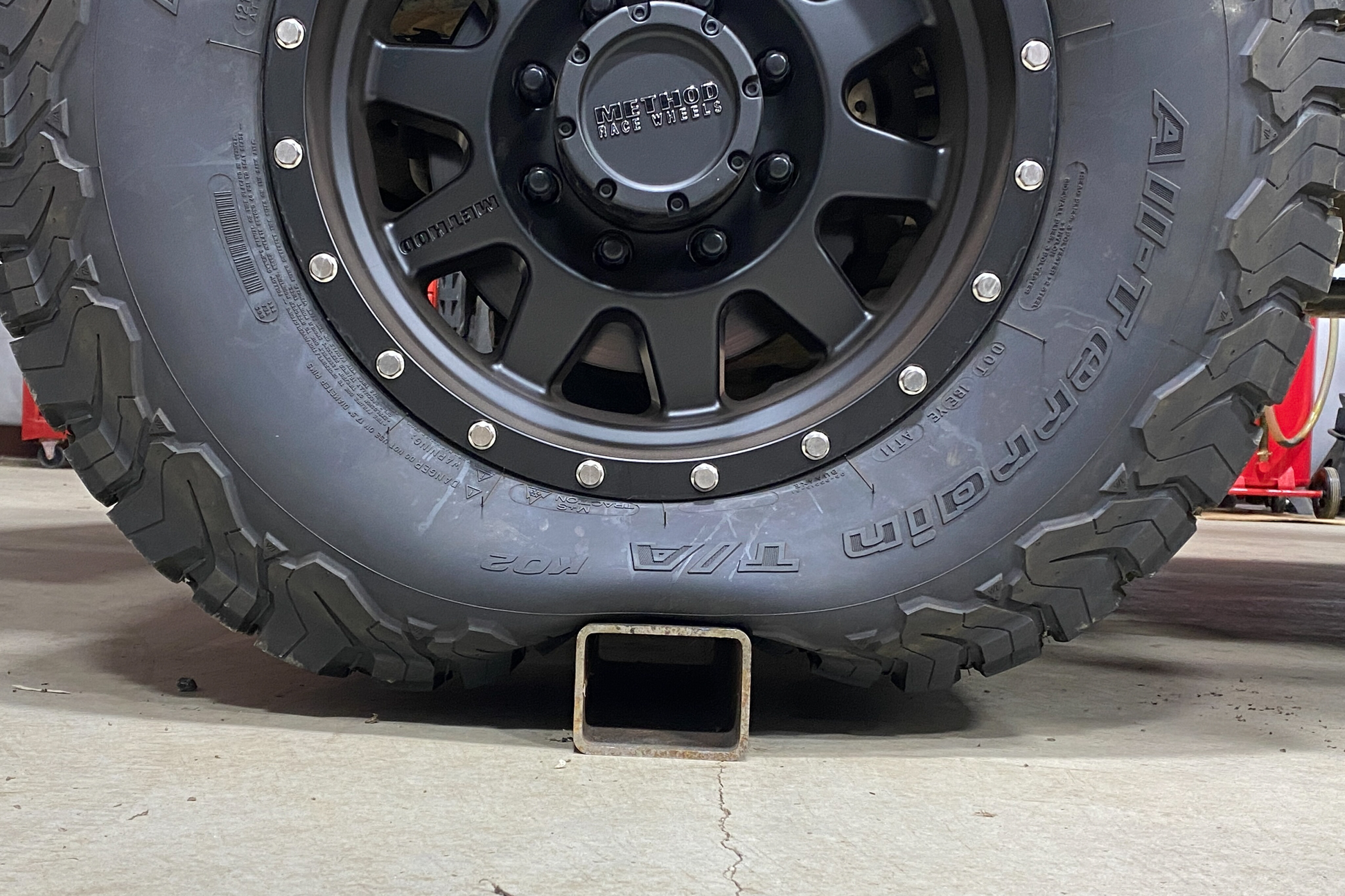
To demonstrate this effect, we’ve evaluated two tyre/wheel combos. The first is a 35-inch BFG KM3 Mud Terrain (load range C), on 15x8-inch Marsh beadlocks (dedicated trail rig, approx. 2300kg).
The second is a LT295/70R17 BFG KO2 All Terrain (load range E) wrapped around 17x8.5 Method 301 alloys (Ram 2500 diesel, approx. 2700kg). Starting with street pressure, we reduced psi in increments while recording contact patch size and deformation.

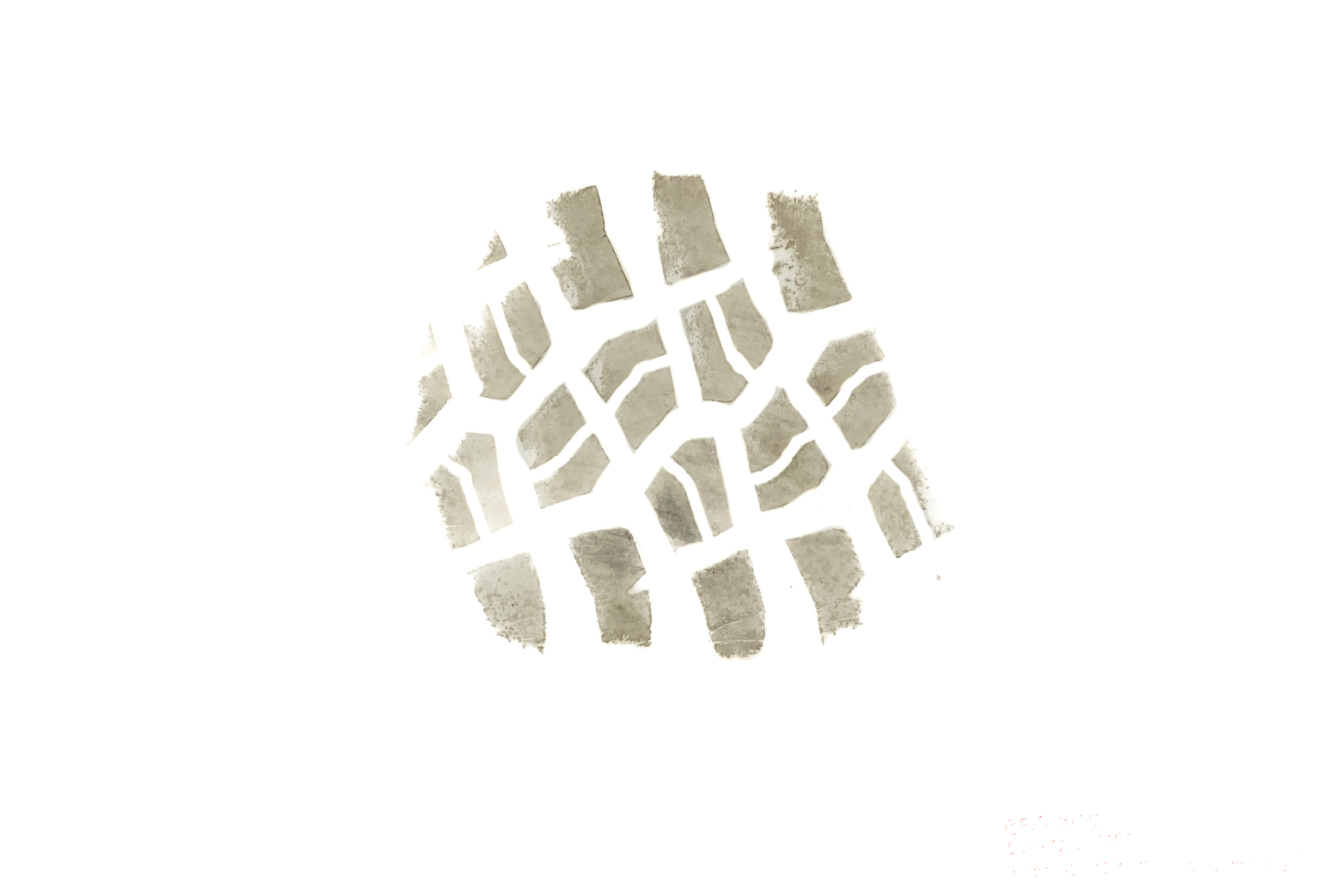
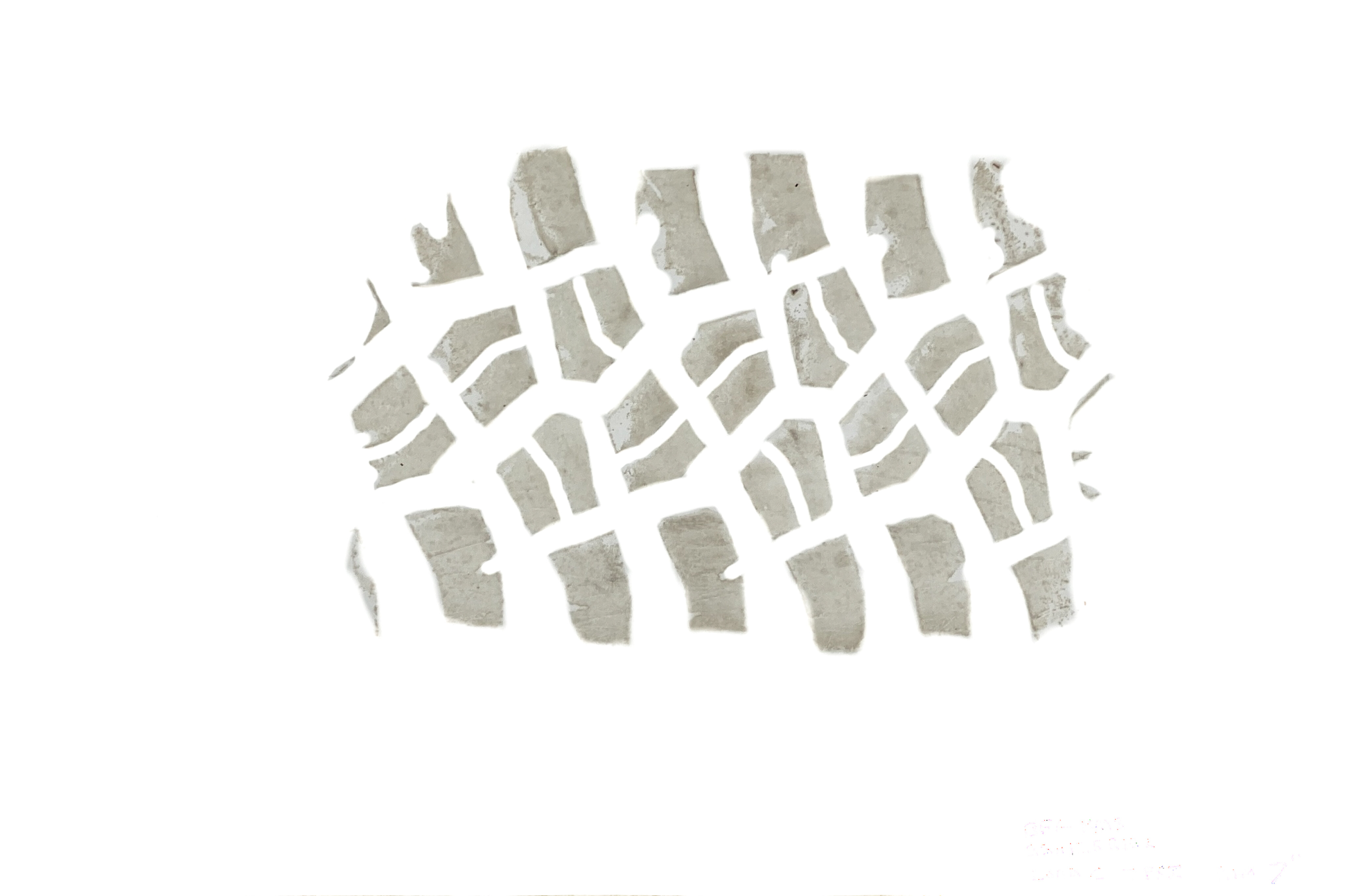
You will note at highway pressure the contact patch for each tyre is appropriately small, but when reduced to 20psi, 15psi, and 10psi it becomes notably larger.
This increase equates to more rubber on the ground, which equates to more floatation and/or deformation. One might argue that reducing tyre pressure reduces ground clearance, which is true, and there are many safety concerns connected with running anything outside the manufacturer’s recommended pressure.
However, when choosing an appropriate psi for a given situation (review the aforementioned variables), lowering the bar is a game changer.
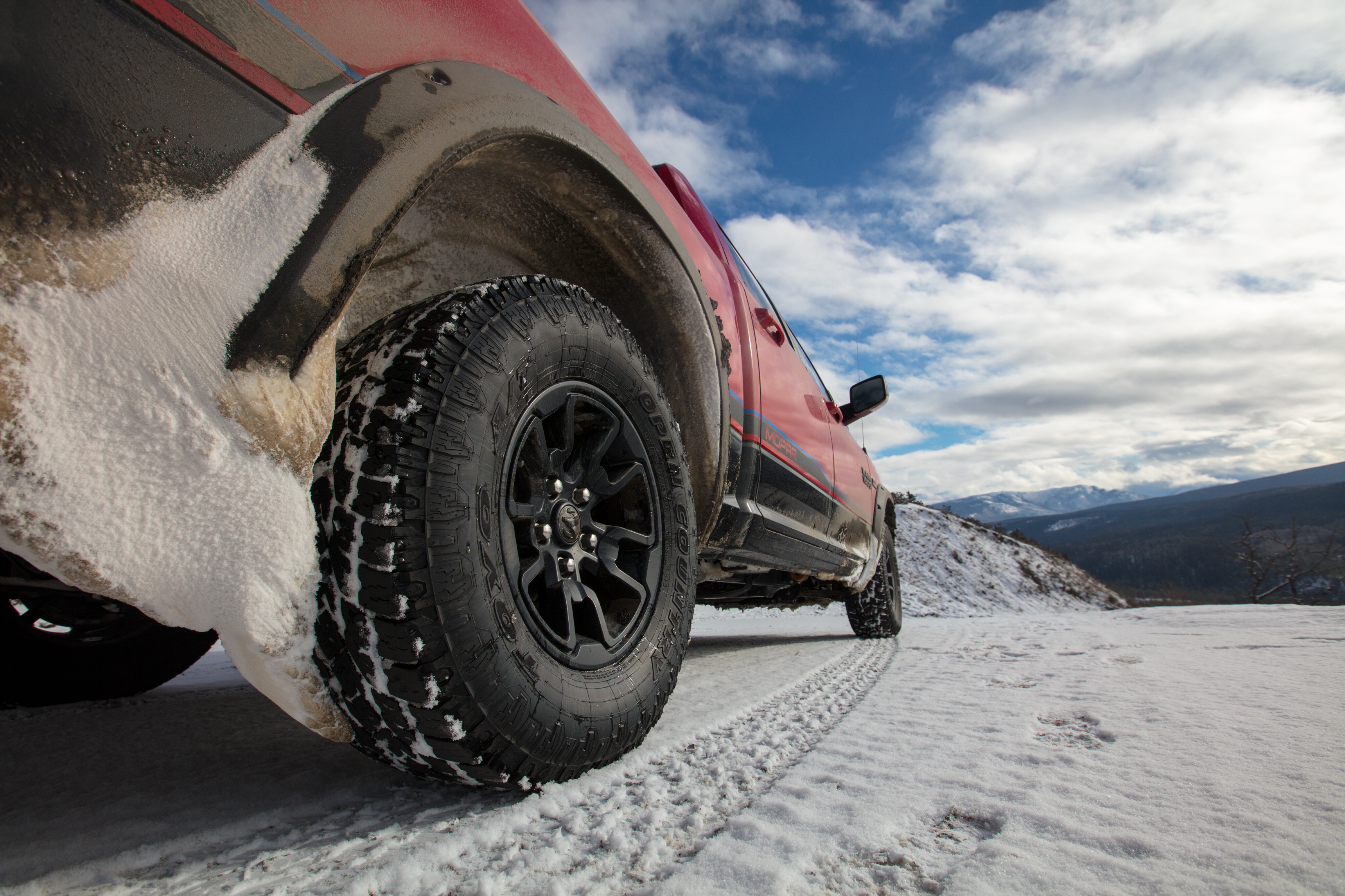
For example, while in Western Australia many years ago I learned of a couple whose car became mired in the sand.
The husband tried to walk out for help while the wife stayed with the car. Both perished from exposure, and when the recovery team arrived they simply aired down the tyres (increased footprint) and drove the vehicle out. Sad but true.
TIP: Reducing air pressure increases a tyre’s footprint, ability to deform in uneven terrain, and grip the tractive surface.
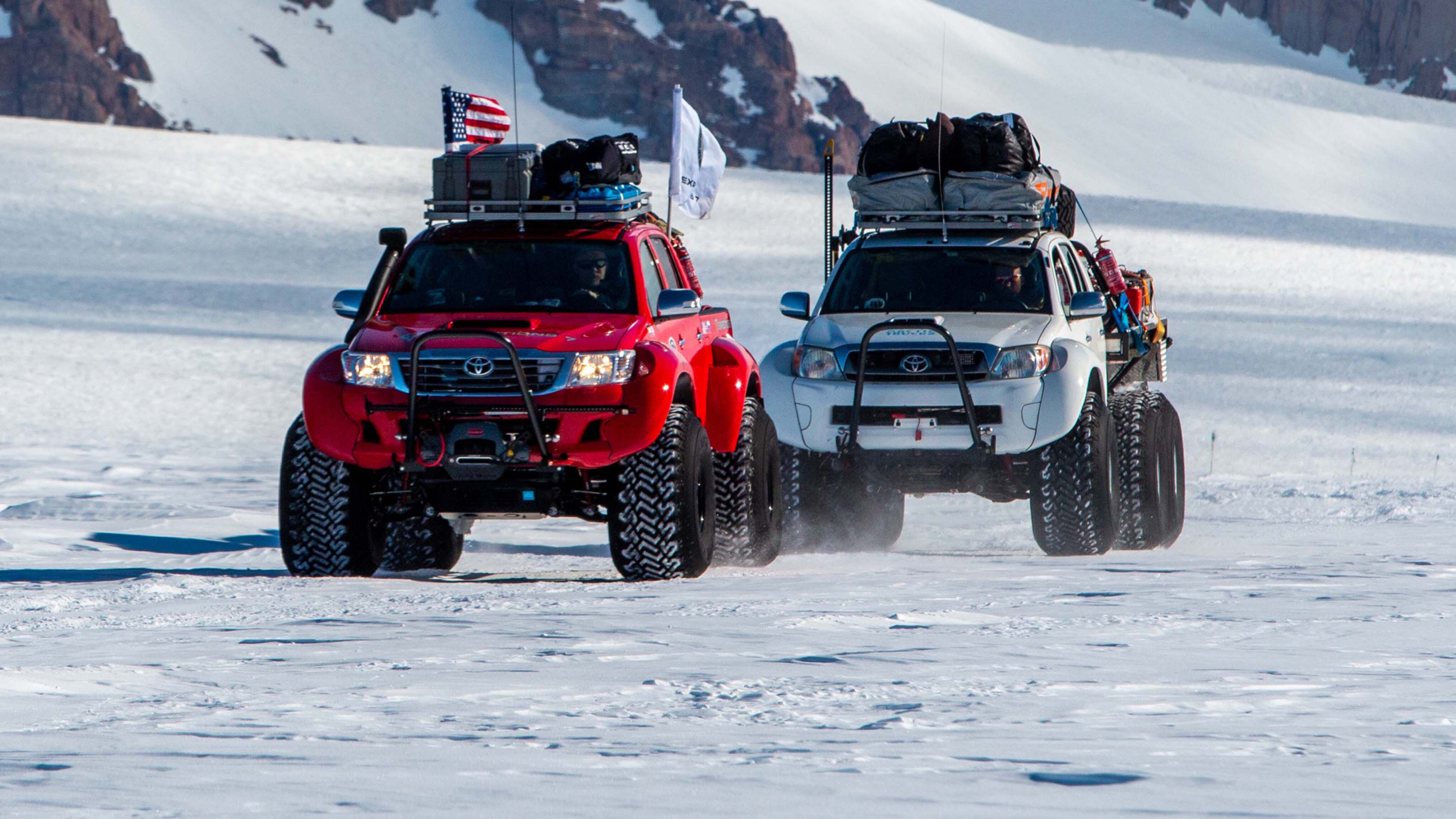
How much?
During a recent fundraiser snow run someone blurted out on the radio, “Everyone should air down to between seven and nine pounds!”
I shook my head in dismay and glanced at my long-time wheeling buddy Matt (also shaking his head), who was driving a new F-150 with 20-inch wheels and low-profile tyres. Our new ‘air referee’ had 40-inch tyres on beadlock rims and the suggested pressure would be fine.
But Matt’s dogs would be flat as a sailor frog, probably come off the rim, and possibly be damaged in the process. So, the million-dollar question is how much should we air down? I can guarantee that one size <i>does not<i> fit all.

But theory and reality, as you know, seldom share common ground.
I will be the first to state there are significant risks to running reduced pressure (legal disclosure here), which include losing a bead, damaging a tyre and/or rim, having an accident, bodily harm, death, dismemberment, and mayhem of all forms.
This is why tyre and automobile manufacturers won’t suggest anything but full street pressure in their official literature. But theory and reality, as you know, seldom share common ground.
TIP: Reducing air pressure increases the risk of damaging the sidewall or rim, or losing a bead and causing an accident. Be cautious and take it slow.
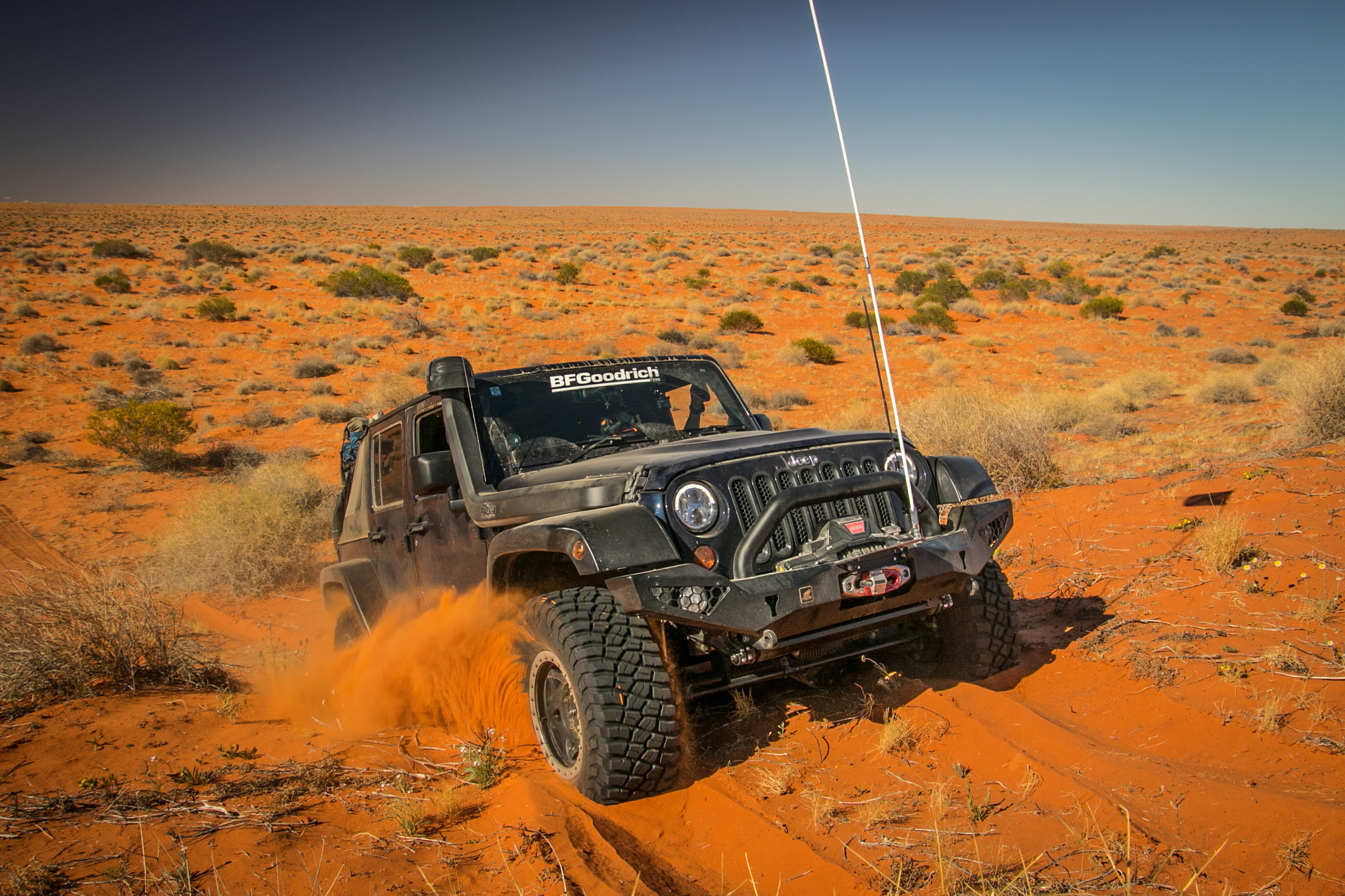
We have seen that at 10psi my Ram 2500 nearly flattens a 33-inch tyre on a 17-inch rim, but at 20psi the footprint is nearly double that of street pressure and there is enough sidewall for cautious driving (no hard turns or I risk losing a bead).
On this vehicle I reserve 15psi or less for <i>I’m-in-a-pickle<i> moments. During treks in Baja, Mexico, (hardpack dirt, sand, mud, rock, etc.) I drop my Tacoma’s 265/75R16 All Terrains to 15psi and leave them there for the entire trip (short pavement sections at 90km/h max) reserving 10psi and lower for emergency situations.
Lastly, my 35-inch KM3s on 15-inch beadlocks are perfectly happy at 7 to 8psi on technical terrain like the Rubicon, Moab or Fordyce.
TIP: One size does not fit all when it comes to air pressure.

The reason is that even at this ultra-low pressure there is still plenty of sidewall for ample deformation and the beadlock mechanically clamps the outer bead of the tyre to the rim – this eliminates peeling off the bead or spinning the rim within the tyre under heavy torque scenarios. The caveat is that few beadlocks are approved for on-road use.
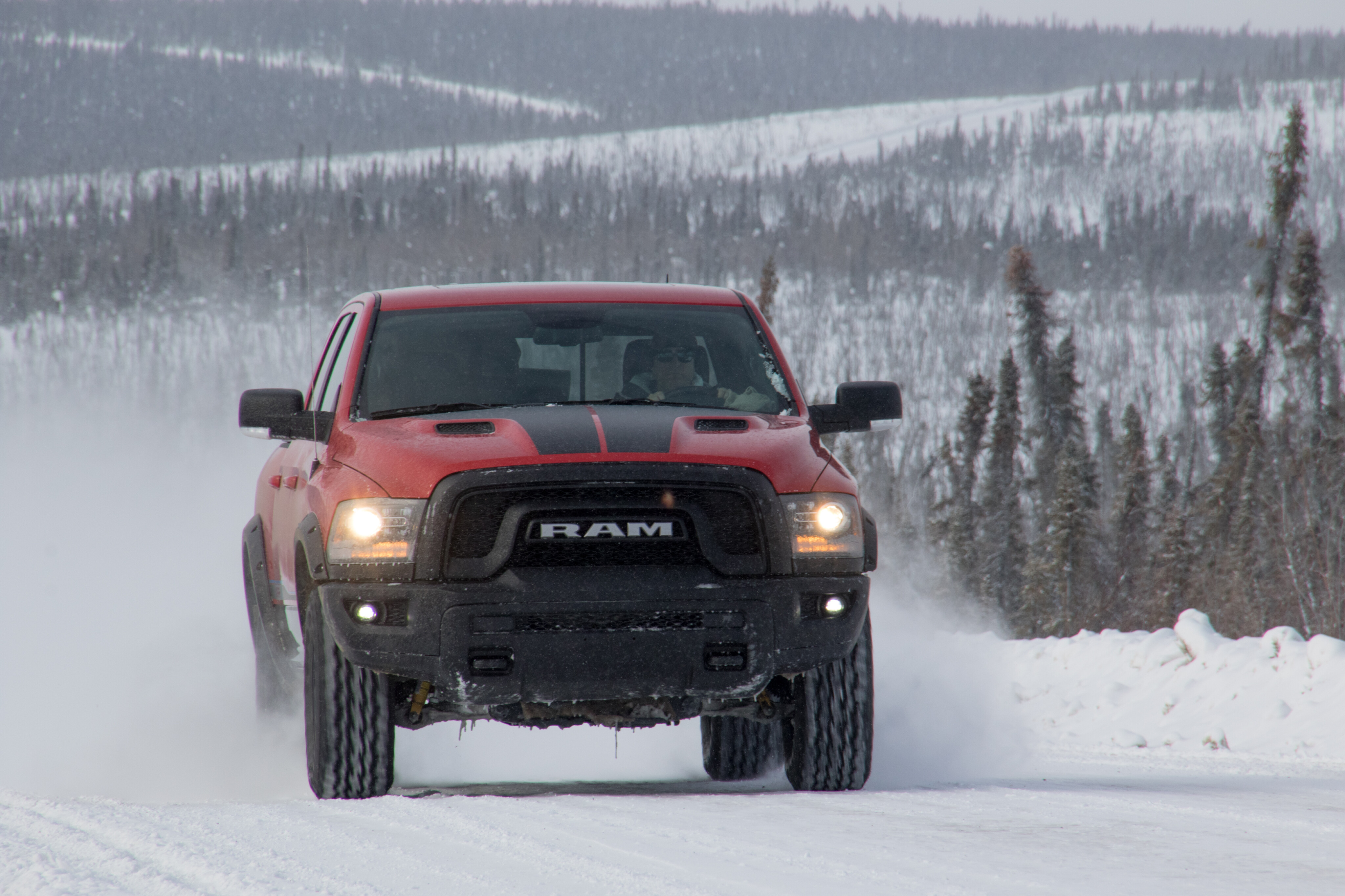
Over the years I have experimented with different tyres on different vehicles in different conditions, and I highly suggest you do the same.
Try dropping to 50 percent of street pressure and put the tyre on an obstacle, take a look at the sidewall, turn the wheel and observe how it reacts, drive it a bit and note performance, and repeat the process until you find a pressure that works for the given terrain.
TIP: Reduce tyre pressure in increments, evaluating sidewall deformation and tyre performance at each level.
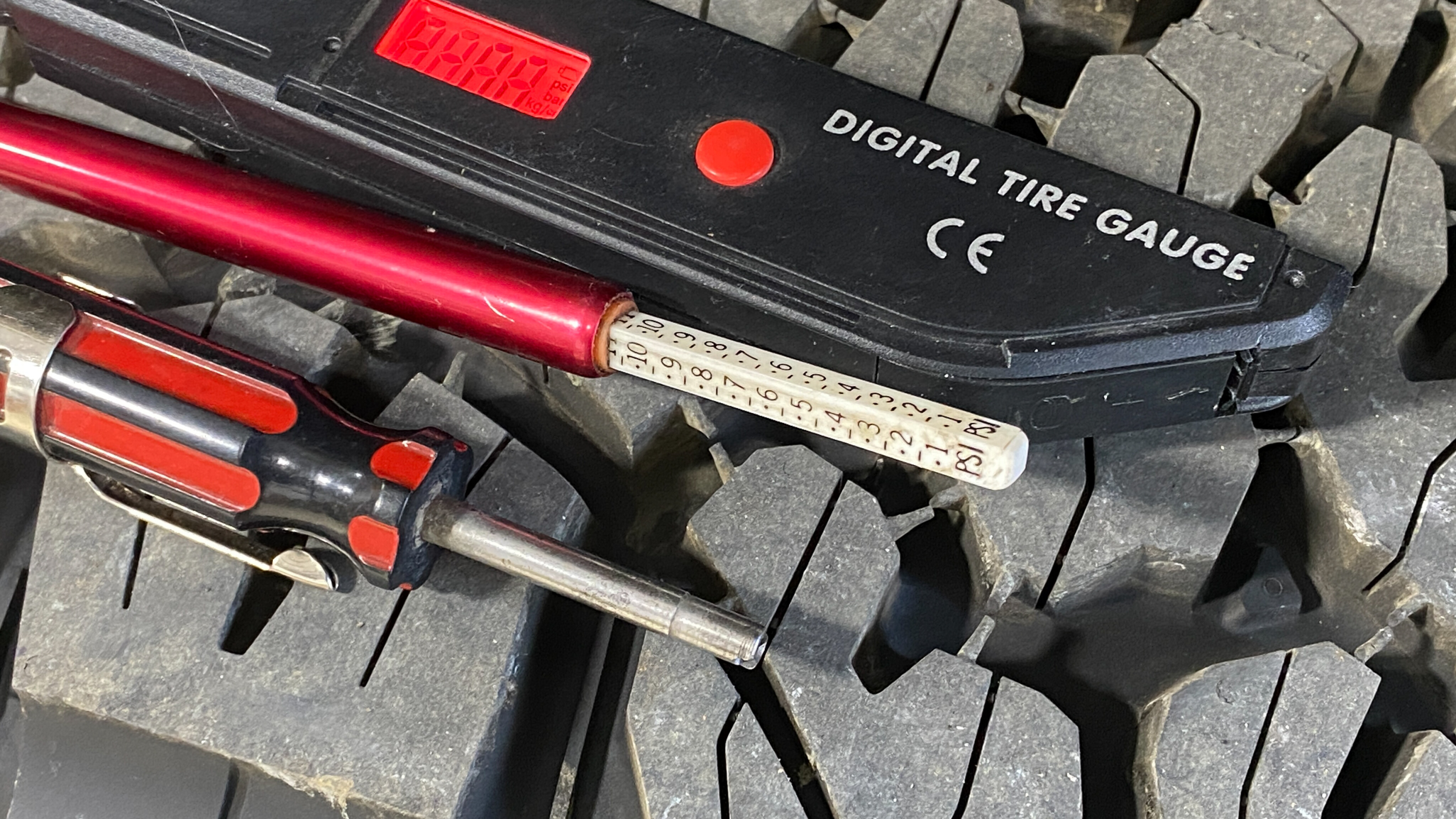
Air up, air down
I might be a bit old-school, but I typically air down by removing the valve core.
This low-buck method will drop a 35-inch tyre from 35 to 15psi in less than a minute, but does require a core removal tool, accurate low-pressure gauge, and watchful monitoring… or you will be pulling out your compressor.
Whether or not you use this technique, it’s a good idea to carry extra valve cores and stems in case you tear one or drop a core – I’ve done a contortionist act with a finger over the stem and the other hand gently mining the sand, mud, or snow for the core.
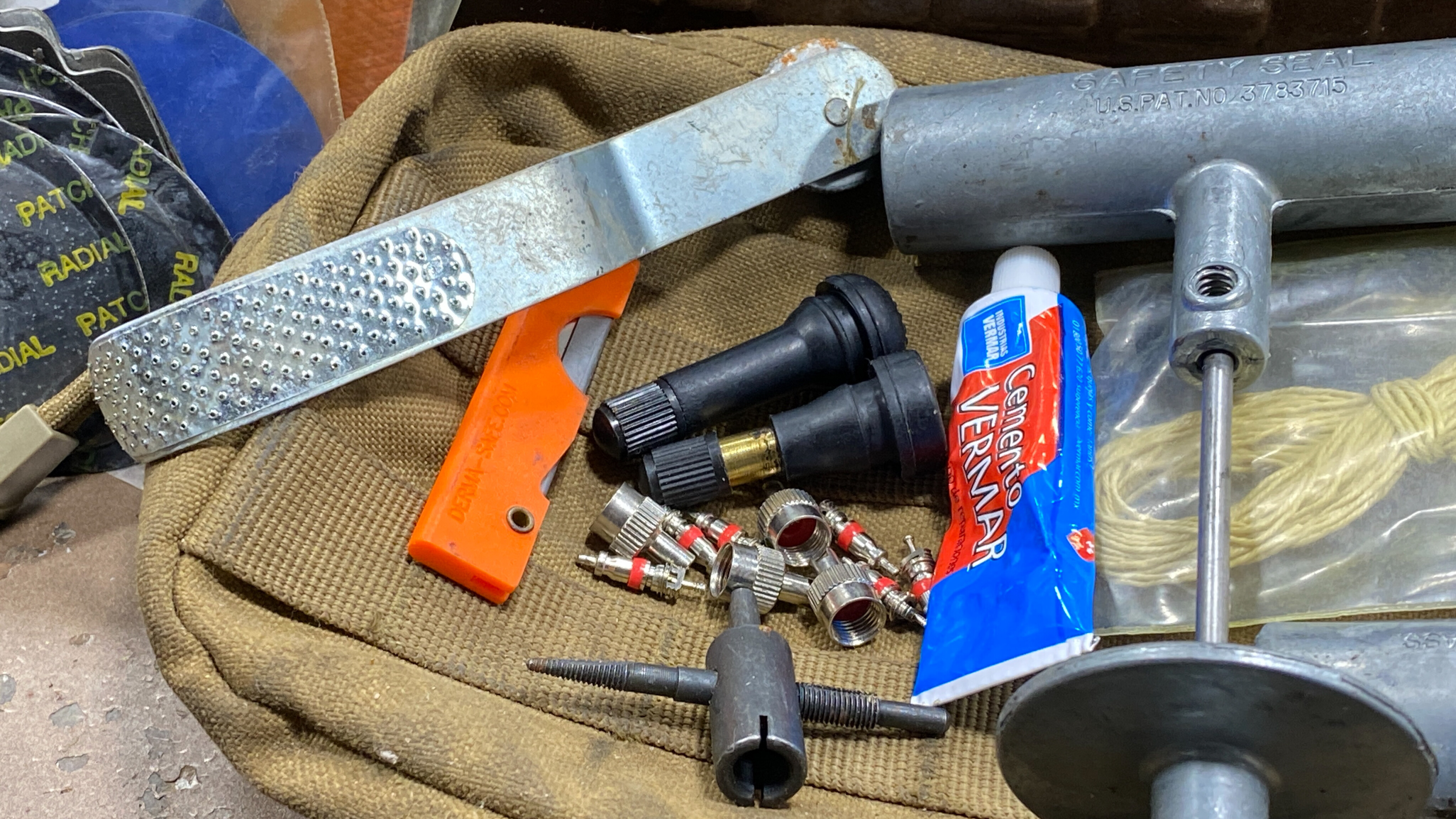
This leads us to the need to air up at the end of the trail. Most folks these days are using electric compressors, but before electrics were available the hot ticket was an engine-mounted belt-driven unit.
They are highly efficient, last forever, and the higher you rev the mill the more air they produce. I run a York piston-style unit on my CJ-7, and a converted rotary-style AC compressor on my ’82 Toyota Hilux. But for my other rigs I have a portable ARB Twin electric that I move from vehicle to vehicle as needed.
TIP: Buy a high-quality compressor, an accurate low-pressure air gauge, and don’t forget extra valve cores and stems.
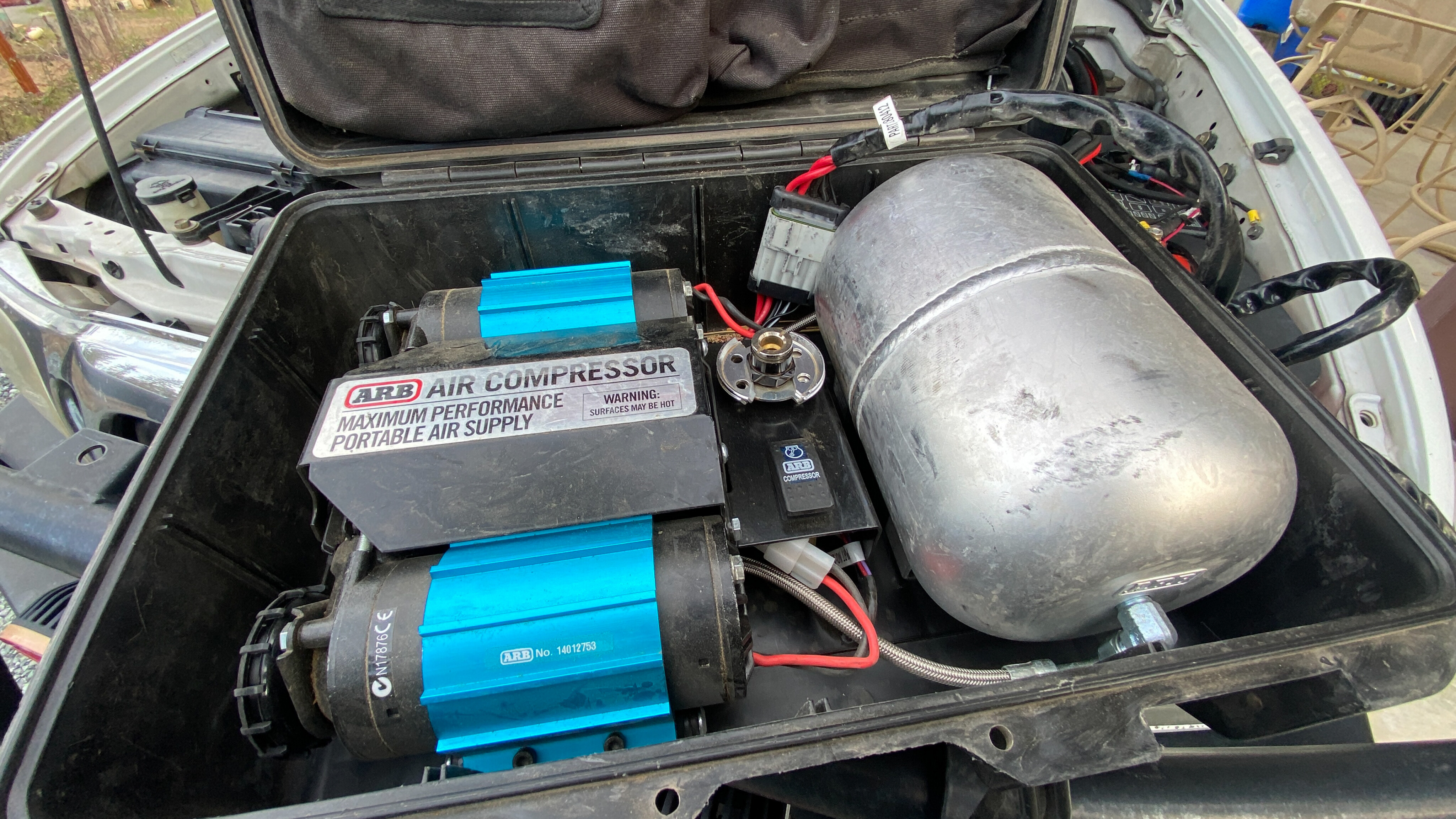
While a single line and air chuck work great, there are dozens of deflation/inflation systems available.
They consist of a manifold and five air lines; one for each tyre and one that feeds from the air compressor. I’ve used MORRflate’s Quad+ unit with good results. Simply hook it to the compressor’s NPT fitting, the other leads to the tyres, and monitor the built-in air gauge.

With a high-quality compressor, air-ups are easy-peasy and I usually air down as soon as I hit the dirt.
Why, because the improved ride and reduced rattling of crew and cargo makes the day much more enjoyable. The increased footprint and improved grip will also help reduce tyre spin, which will extend tyre life and be easier on the trail and environment.
TIP: With most tyres, reducing pressure approximately 50 percent will improve off-road ride quality.

Wrap-up
When I think about 20-something me asking, “Whatcha doing,” or the Air Referee’s “seven and nine pounds” comment, I don’t pass judgement.
Heading into the backcountry, whether for the first time or hundredth time, there is always a new skill to learn or improve upon. I’ll be heading to Moab next month, followed by a week in Mexico’s Gran Desierto de Altar and three weeks in Baja, nearly all on the dirt and aired down. I can’t wait to see what these next adventures teach me. See you on the trail.
*This tyre pressure guide is not gospel. Always run recommended tyre pressures when driving on the road.

COMMENTS